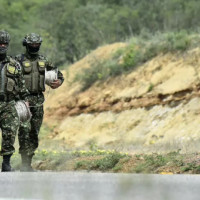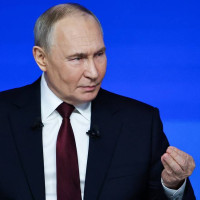- Sunday, 21 December 2025
Southeast Asian defense chiefs meet in Laos
Vientiane, Laos, Nov. 21: Opening the talks, Laotian Defense Minister Chansamone Chanyalath said he hoped for productive meetings that would "become a standard for us to continue ASEAN’s cooperation in defense, including how to handle, thwart, and manage security threats in the present and in the future.”
As China has been more assertively pushing its claims in recent years, ASEAN members and Beijing have been negotiating a code of conduct to govern behavior in the sea, but progress has been slow.
Officials have agreed to try to complete the code by 2026, but talks have been hampered by sticky issues, including disagreements over whether the pact should be binding.
Philippine President Ferdinand Marcos Jr., who has called for more urgency in the code of conduct negotiations, complained at the meeting of ASEAN leaders last month that his country “continues to be subject to harassment and intimidation” by China’s actions, which he said violated international law.
Chinese and Philippine vessels have clashed repeatedly this year, and Vietnam in October charged that Chinese forces assaulted its fishermen in disputed areas in the South China Sea. China has also sent patrol vessels to areas that Indonesia and Malaysia claim as exclusive economic zones.
At the meeting of ASEAN leaders last month, U.S. Secretary of State Antony Blinken said Washington was "very concerned about China’s increasingly dangerous and unlawful activities in the South China Sea which have injured people, harm vessels from ASEAN nations and contradict commitments to peaceful resolutions of disputes.”
He pledged that the U.S. would "continue to support freedom of navigation, and freedom of overflight in the Indo Pacific.”
In response, Chinese Foreign Ministry spokesperson Mao Ning said U.S. and other non-regional militaries present in the sea were the main source of instability.
“The increasing military deployment and activities in the South China Sea by the U.S. and a few other non-regional countries, stoking confrontation and creating tensions, are the greatest source of instability for peace and stability in the South China Sea,” Mao said.
It is not yet clear how the incoming Trump administration will address the South China Sea situation.
Indonesia, Thailand, Singapore, Myanmar, Cambodia, and Laos are the other ASEAN members.
It remained unclear whether Austin plans to meet China's Defense Minister Dong Jun on the sidelines of the ASEAN meetings, but Japanese Defense Minister Gen Nakatani is expected to meet with Dong to express his concerns over Beijing's military activities, Japan's NHK reported.
Japan has protested that a Chinese military aircraft violated its airspace briefly in August, and in September Japan expressed “serious concerns” after a Chinese aircraft carrier and two destroyers sailed between two Japanese islands.
The meetings are also likely to touch on the tensions in the Korean Peninsula, the Russia-Ukraine war, and the wars in the Middle East. They also expect to discuss other issues, including natural disasters, cybersecurity and terrorism.
Another thorny regional issue is the civil war and humanitarian crisis in ASEAN member Myanmar. The group's credibility has been severely tested by the war in Myanmar, where the army ousted an elected government in 2021, and fighting has continued with pro-democracy guerillas and ethnic rebels.
More than a year into an offensive initiated by three militias and joined by other resistance groups, observers estimate the military controls less than half the country.
Myanmar military rulers have been barred from ASEAN meetings since late 2021, but this year, the country has been represented by high-level bureaucrats, including at the summit in October. (AP)










-(1)-original-thumb.jpg)




